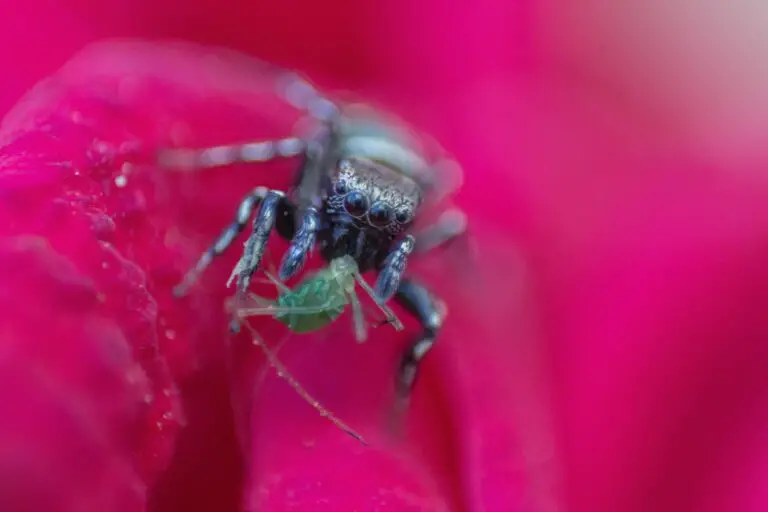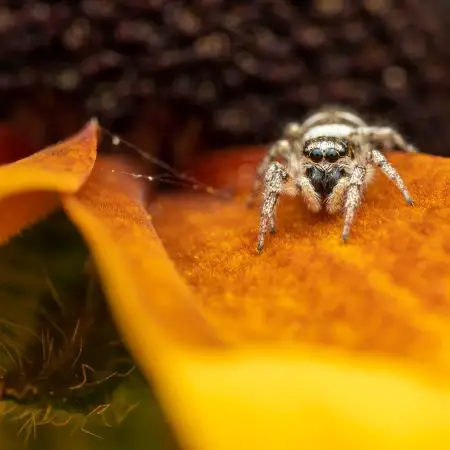Behavior of Jumping Spiders
Many people glance away from spiders without a second thought, but have you ever watched how they act? More specifically, have you ever noticed the behavior of jumping spiders?
If the answer to these questions is no, then you might just find yourself paying closer attention to these little, eight-legged predators next time. With jumping spiders found all over the world, there’s a big chance you’ll see one soon. Not only do they have the ability to jump more than their body length, jumping spiders have also been proven to be very intelligent. They take part in activities that are truly extraordinary for their size.
One of the most interesting things about a jumping spider is that it is always looking around. It is constantly scanning its surroundings for potential prey or danger. If it spots something it wants, the spider will stalk its prey before attacking.
Most species of the jumping spider family are known for their curiosity. If they see something new, they will often approach it to take a closer look. This can sometimes lead to them getting themselves into trouble, but it’s also part of what makes them so fascinating to watch.
Lastly, all jumping spider species are incredibly active. They move around a lot, and they are always busy exploring their surroundings. The characteristics mean that they are a lot of fun to watch, especially if you have never seen one before.
However, there are particular behaviors of jumping spiders that we, as humans, might be more interested in learning more.
Fight or Flight?
You’ll have likely heard the saying that spiders are much more afraid of you than you are of the spider, and we can believe this to be true. When it comes to interacting with potential predators or prey, jumping spiders have three options: fight, flight, or freeze.
Many jumping spiders that feel threatened will usually try to fight off their attacker. They’ll do this by jumping onto the insect or predator and biting it. If they can’t fight, they’ll usually try to flee. They can do this by running away really fast or by jumping to a new location.
However, if a jumping spider feels like it’s outnumbered or can’t escape, it will usually freeze in place. This allows the spider to avoid being seen and avoid being attacked, which increases their chance of survival.
Are Jumping Spiders Dangerous?
Jumping spiders are not always aggressive; however, they are not dangerous. In fact, jumping spider behavior shows them to be very docile creatures. If you see a jumping spider in your home, there is no need to be alarmed.
Like all creatures, if felt threatened, most spiders can be aggressive. In the case of a tiny jumping spider, a person does not need to be afraid. They usually only bite humans if they feel threatened and can’t run away, so it is important to remember you should never crowd or corner a jumping spider.
If you ever need to treat a spider bite, you can find advice here.
Hunting
Jumping spider hunting behavior is slightly different than the common house spider. This type of behavior has been called “sit and wait.” It isn’t as still as it sounds, however; jumping spiders are active hunters.
As they have the best vision, these spiders will usually find a spot that’s high up and has a good view of their surroundings. They’ll then sit and wait for insects to come by, using their strong sense of vision to spot their next meal. When any insects come close, the spider will jump onto their prey to attack. In some cases, jumping spiders have stalked their prey before jumping into attack, hence their name.
Jumping spiders are generally more active during the day, and this means they are more likely to hunt then, too. This might be due to their eyesight being better when their surroundings are well-lit. They use their vision to track potential prey.
How Do Jumping Spiders Hunt?
Instead of constructing a web to tangle small insects in, jumping spiders use their powerful jumping legs to leap on to their prey. They do this from high up, and can spot other insects on the ground with ease. They’re also able to run very quickly, so they can catch up to their prey if they need to.
Their mouthparts are very strong. The pedipalps, which are appendages near the mouth, are used to catch and grip insects to allow for easier feeding; they also use their front pair of legs to do this. This is aided by the sharp fangs at the tips of their chelicerae, which can inject their prey with venom.
Jumping spiders are also able to produce silk. They use this to line their nests and to make a safety line when they jump. When they are hunting, this safety line is used in case they miss their target when they’re leaping onto prey.
Mating
Mating season for jumping spiders usually lasts from late summer to early fall. During this time, the males will search for a female to mate with. He will come across several potential mates before finding a female who reciprocates. Male jumping spiders have been known to court other species, instead of finding their female counterpart.
Males will usually approach a female cautiously. They will perform intricate moves with his legs, and these moves have become fondly known as dancing, to indicate to the female that he wishes to mate. It is believed that these moves prevent the female from attacking and eating the male. If the female is receptive to the male jumping spider’s mating dance, which is best shown by the vibrant colors of the peacock spider, then the male will reach his front legs out towards the female. He will then climb on top of her and insert his pedipalps (a pair of appendages near the mouth, which are often used to signal other spiders of the same species or capture prey). After the male ejaculates, he’ll usually leave the female’s web.
However, as briefly mentioned, mating is a risk for most jumping spiders, especially male spiders. If the female isn’t receptive to the male’s dance, she might decide to eat her potential partner. This can occasionally happen during or after mating.
If mating is a success, female jumping spiders will lay their eggs in a silken sac. Female spiders will guard their eggs until they hatch a few weeks later. There could be up to 300 spiderlings in a single egg sac, and these spiderlings will stay with their mother until they have gone through their first molt and are old enough to fend for themselves.
Can Multiple Jumping Spiders Live Together?
When kept as pets, it is essential to remember that jumping spiders are solitary creatures and should not be housed together. These spiders will only socialize when mating; even then, this situation can be unsafe. If more than one jumping spider is kept in an enclosure, the spiders might fight each other, which might be fatal to one or both of the jumpers.
Webbing
All species of spiders have spinnerets on their abdomens that they use to produce their silk. However, not all spiders spin webs to capture flies and such.
Jumping spiders don’t build webs to hunt as they rely on their powerful jumping legs to reach prey. Instead, they use their web silk to create a shelter for themselves, which is often referred to as hammocks.
They spin cocoon-like nests when they are about to molt or lay eggs. This is often thicker than their hammocks as they are very vulnerable during the molting process and need extra protection from dangers, like nighttime predators. It also provides them with a safe place to lay their egg sacs, where the spiderlings can hatch without harm.
Also, jumping spiders use their webbing to create tracks when they are climbing; this allows them to better grip the surface to prevent any falls. If you watch a jumping spider crawl, you might notice that the end of its abdomen (where its spinneret is located) taps down on the surface every so often; this is the spider sticking its silk thread to form tracks. The silk line jumping spiders produce is known as a dragline.
Draglines are especially useful when a jumping spider is leaping. If a jump is miscalculated, then the dragline is there as a safety line to allow the jumping spider to climb back to its original perch. This part of their hanging behavior is very clever.
Does Webbing Change as Jumping Spiders Age?
The amount of webbing that a jumping spider produces does not change as the spider ages. However, the quality of the webbing does change.
As a jumping spider gets older, its webbing will become less sticky; for some species of spiders who hunt with their webs, this means the webbing will be less likely to catch prey. This is because the spider’s silk-producing glands will start to slow down as it gets older. In captivity, jumping spider enclosures can be lined with simple mesh to help an aging spider climb the walls.
Do Jumping Spiders Hibernate in Webs?
Although jumping spiders do not hibernate in the traditional sense, they do enter a state of diapause in the colder months. Diapause is a temporary pause in development and growth because of unfavorable conditions, such as a lack of food and shorter daylight hours. Jumping spiders in the wild will be less active during this time.
Pet jumping spiders might not experience diapause as their conditions are controlled; the enclosure lighting and temperature is unlikely to change, and their owners will supply feeder insects regularly.


